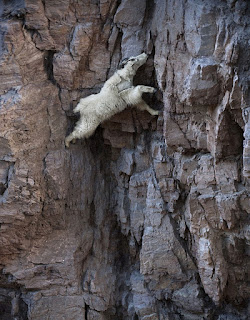Goat people are motherfucking ninjas. Hoary survivalists living in vertical villages clinging to cliff faces. Bandits with iron-dipped horns pronking down the slope towards you, whirling the skulls of their ancestors above their heads. Goat-monks balancing on mountain peaks or at the tops of trees, listening to the voice of the earth in tiny vibrations.
Hyena-folk (gnolls)
Hyena-folk are matriarchal. The hyena-men are slinking and submissive, scheming behind the scenes, wearing painted veils. The hyena-women are ruthless and cruel. They have both a phallus and a womb and so consider themselves 'complete'. Their word for 'male' literally means 'womb-lacker'. They worship a priapic mother goddess called the Autofecundator. The matriarchs prepare for war by impregnating themselves with powerful spells, which they then disgorge from their wombs on the field of battle.
Amphiprions (clownfish-people)
They look mostly human, except for the eyes. They live in the Envenomed Wood, where there are 97 different types of venom & poison, from the trees to the snakes to the deadly black moths. The Anemonides expose their children to all the poisons to make them immune. If you get a transfusion of anemonid blood then you will gain their immunity for a few days.
All of the children are born male; a single woman presides over the tribe. When she dies, the men fight for the right to replace her. The winner carefully removes her womb and inserts it into his own abdomen. There is only one womb and they have had it for as long as anyone can remember.
Crocodile-folk
Pirates of the saltwater estuaries. They live in floating villages that can be disassembled, wrapped in watertight skins, and hidden at the bottom of the river. When they face organised resistance in an area they simply leave, float out to sea, drift to another continent where their last appearance is barely remembered by the short-lived people of the land.
They can enter a death-trance where they need no sustenance for months. Sometimes one navigator guides an entire tribe across the sea while they are comatose, tied together with long lines.
They do not age, but grow larger with each passing year. The biggest are also the wisest. Their children cling to their flanks, build houses on their backs. These elders require massive amounts of food, so they enter the death-trance frequently. Eventually they choose not to wake up and slowly transform into giant logs. Then over years they are cut up to make tools and weapons for their descendants.
The biggest crocodile-folk are hundreds of years old and know many forgotten things. When they become wood, their secrets are inscribed like tree rings in their flesh.
Ant-orcs
First there is the Queen, with a human upper body and a bloated abdomen. With her ovipositor she lays eggs in the fecund earth. Humanoid creatures are born from these eggs, each one a dull-eyed brute, empty of identity.
The Queen daubs a handprint of scented paste across the ant-orc's face. The smell gives it a purpose and a personality. Different smells make different types of orc: belligerent soldiers, cheerful labourers, anxious scouts, evasive diplomats. If the scent is wiped off the orc regresses to a tabula rasa and seeks to return to its mother.
Their memories are also scents - kept in blobs of jelly under their armpits. All orc bodies are interchangeable. If one dies then its memories can be scooped out from its armpits and stuck into a new body.
Splashing the ant-folk with strong smells will drive them insane. Mixing together different scent-identities creates strange hybrids, often hostile to their mother and/or wracked by existential confusion.
Aphid-folk
Their bodies are made of wet clay. They can clone themselves by moulding a new body out of fresh clay and spitting into its mouth to bring it to life. The clone retains the memories of its creator up to the moment it was brought to life.
They conceive of identity as a spectrum rather than a binary. Two clones recently diverged will consider each other to be almost part of themselves - like two limbs of the same body rather than two separate beings. They don't fear death of a single body, only annihilation of the entire lineage.
Their secret weakness is corruption of the lineage. If you can trick them into growing apart from their clone-siblings, then their sense of identity stretches like warm toffee... stretches, snaps, and then they fall to fighting each other, horrified by what they see in the mirror.








No comments:
Post a Comment